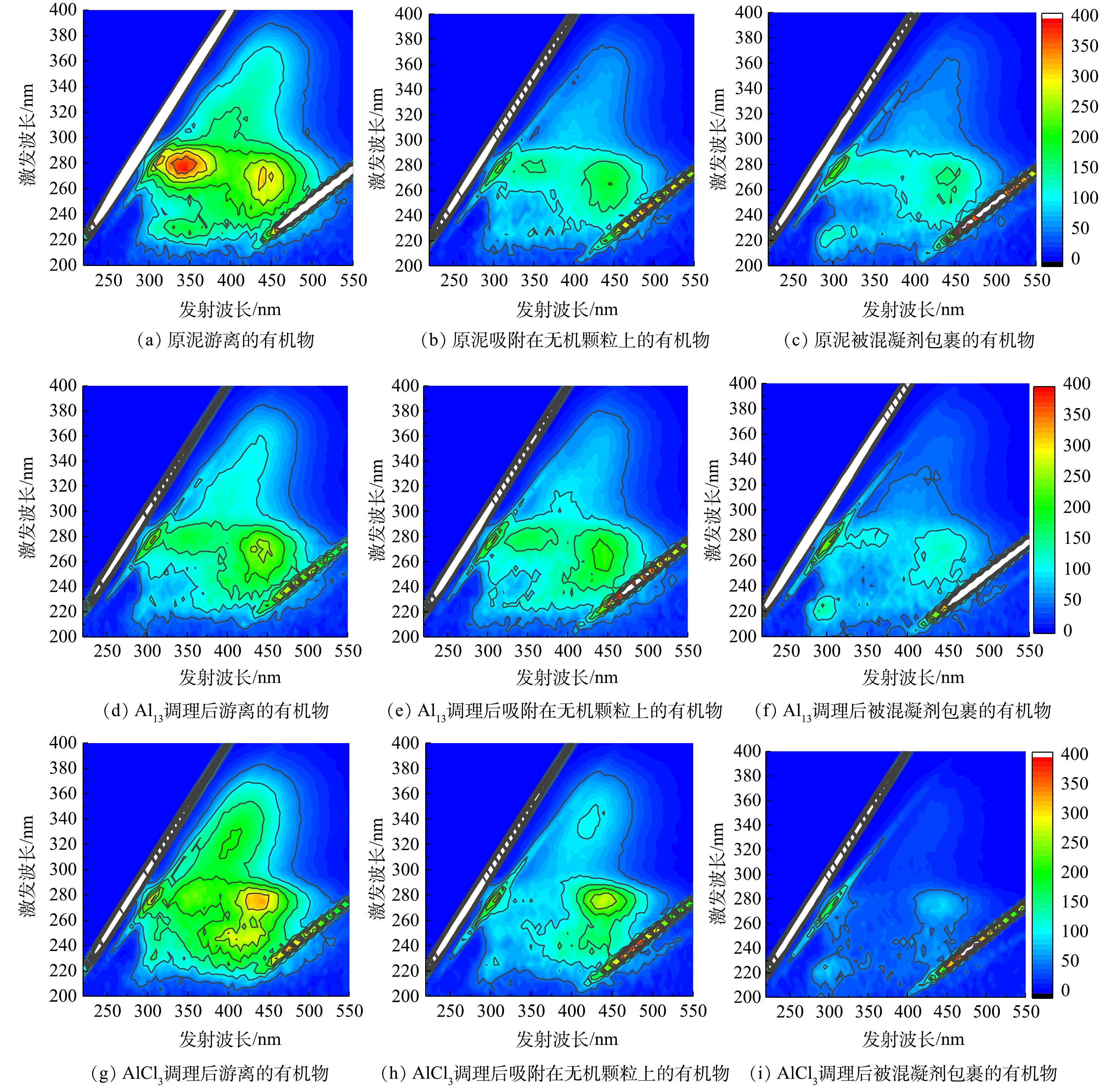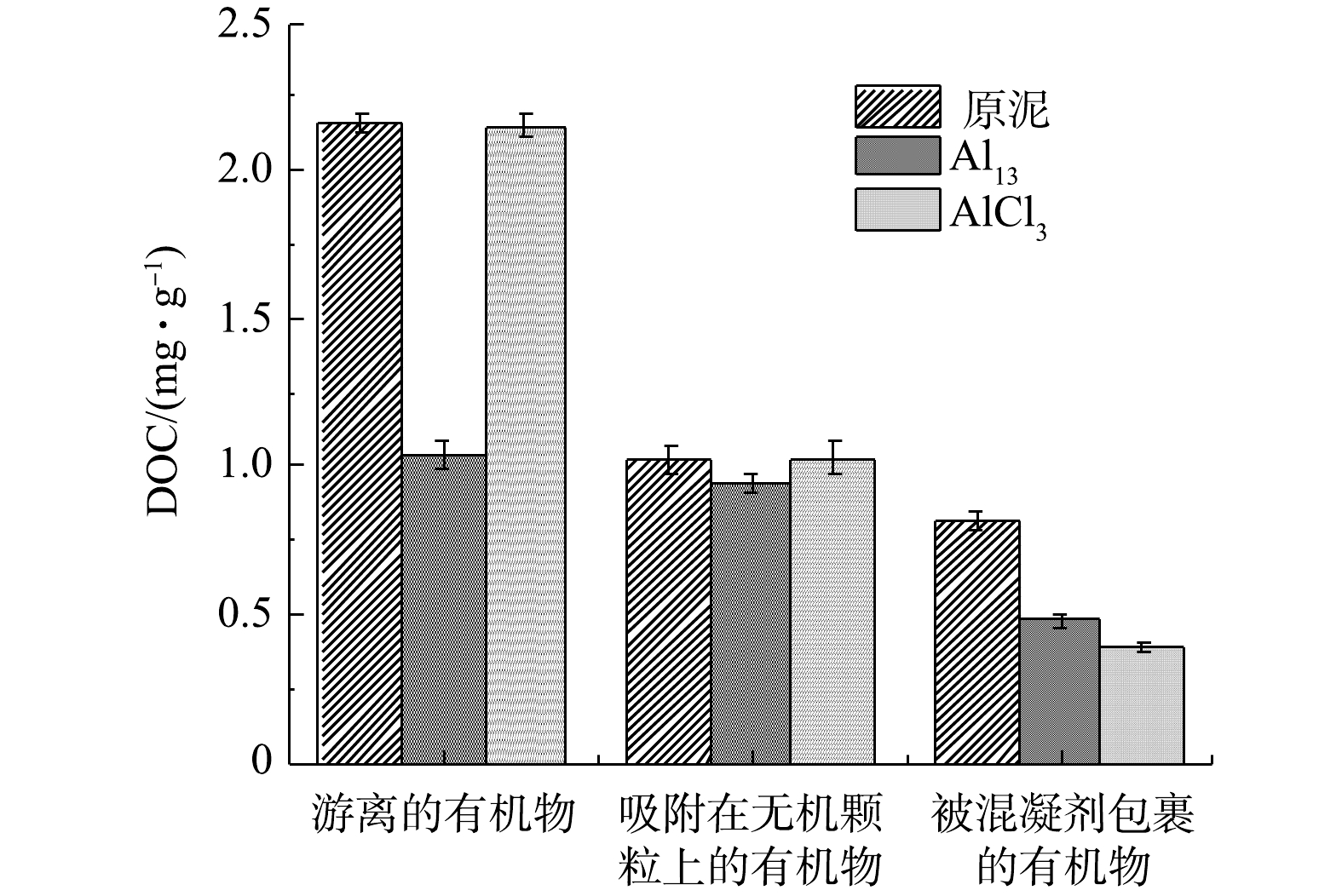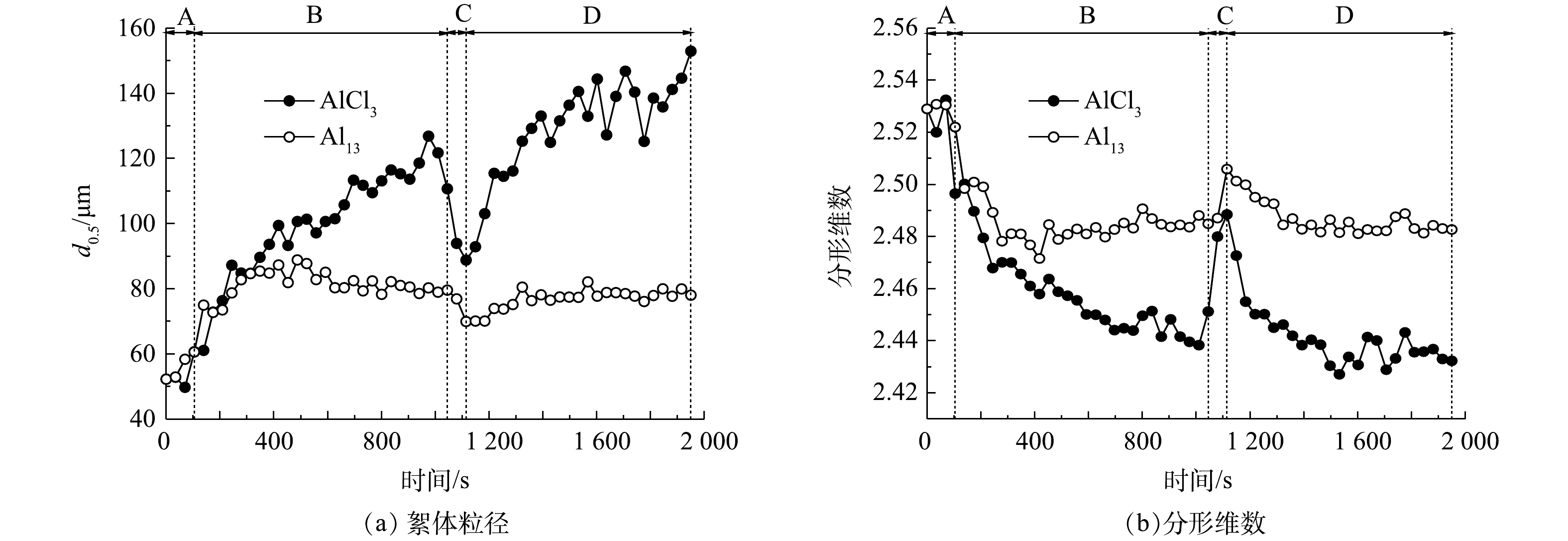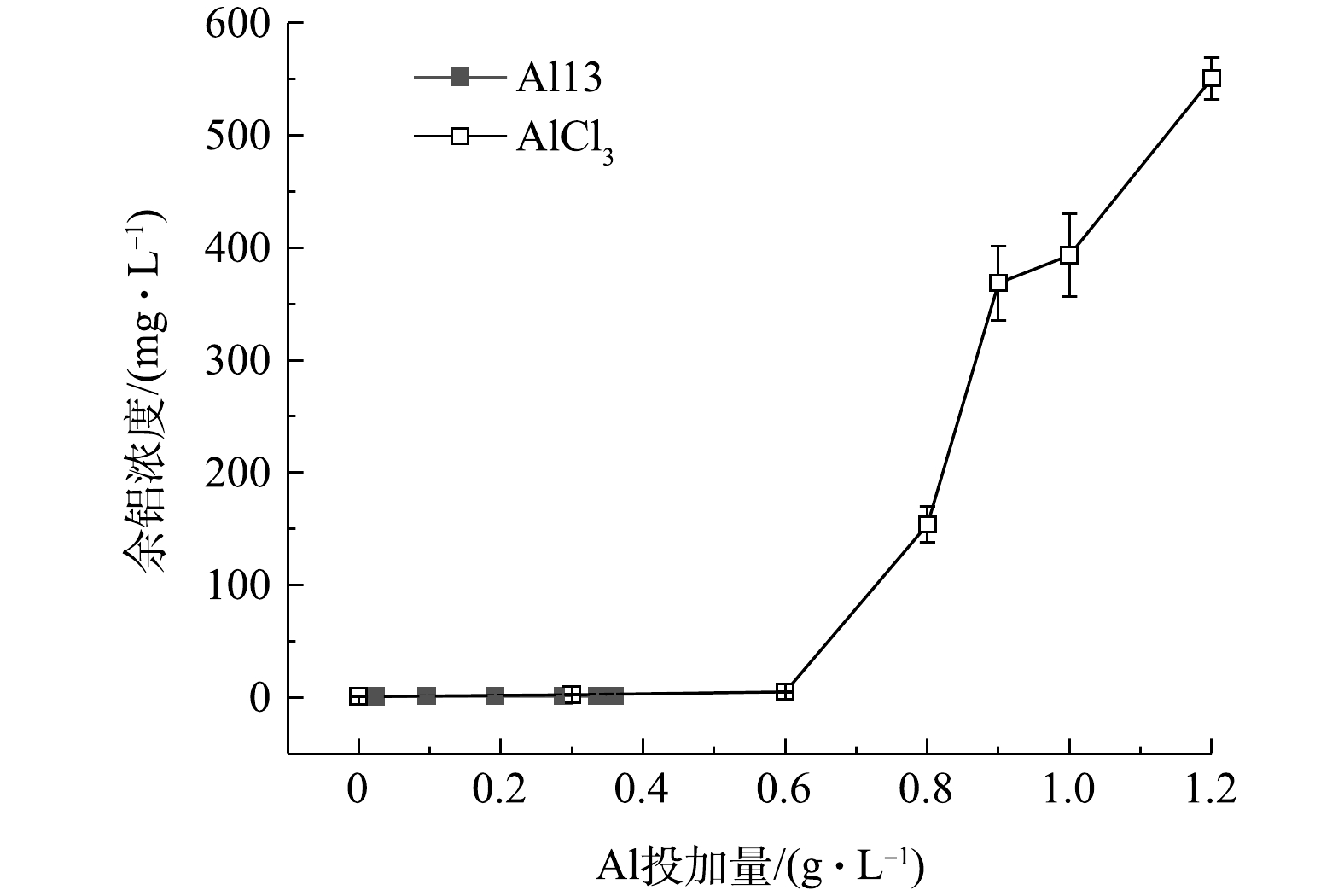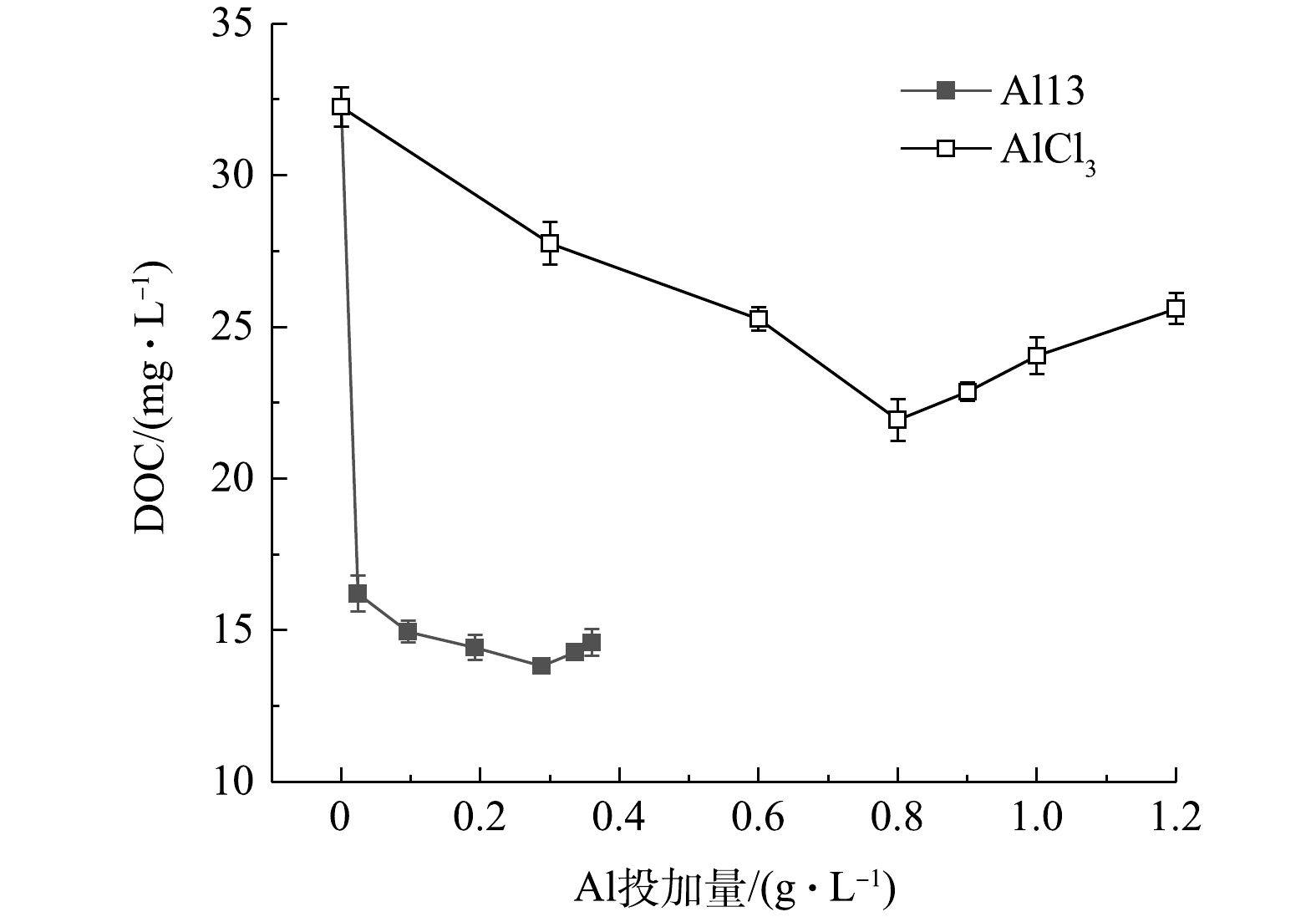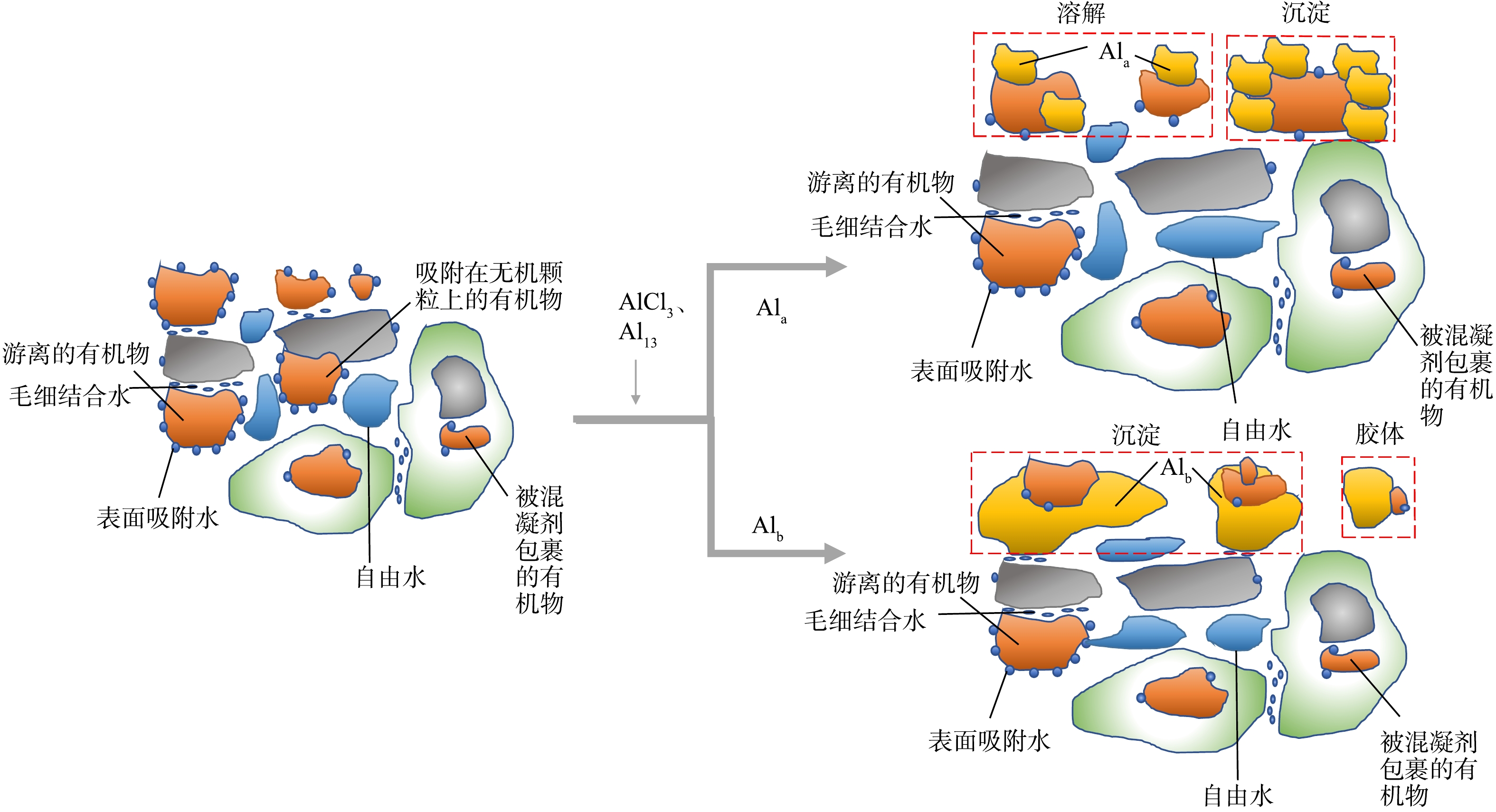-
近年来,我国城镇居民用水量不断增大,给水厂自来水产量也随之提高[1]。在自来水生产的同时,会产生大量的污泥,这部分污泥源于生产工艺中的沉淀池排泥水和滤池反冲洗水,主要为原水中的无机颗粒、有机物以及净水过程中投加的混凝剂[2]。其产量约占自来水总生产水量的4%~7%,为避免资源浪费,应设法将其回收利用[3-4]。
化学调理脱水是污泥脱水常用的方法[5]。常用的化学调理剂有PAM等有机高分子调理剂和铁系、铝系等无机调理剂[6]。PAM在较少的投加量下便可达到较理想的效果,如给水厂中常用阳离子PAM来对污泥进行调理,但其具有轻微毒性,泥水分离后的水不能回用,会对给水厂造成较大的损失。铁系混凝剂絮体形成快,但本身不稳定,且投加到水体中存在色度问题[7-8]。对于铝系混凝剂而言,由于铝形态的不同,其絮凝效果和机理也相应不同[9]。羟基铝盐絮凝剂的形态可分为Ala、Alb、Alc。Ala为低聚态铝,如单体铝AlCl3;Alb为中聚态铝,如Al13(分子式为[AlO4Al12(OH)24(H2O)12]7+);Alc为高聚态铝,如Al30。相对于单体铝来讲,聚合铝具有投加量少、污泥产生量少、电中和能力高、对pH和温度有更高的适应能力等优点[10]。Al13是铝离子水解过程的中间产物,是一种高电荷的纳米粒子。与其他混凝剂相比,Al13电中和能力更强,其在混凝、除氟和污泥调理等方面均有应用[11]。刘沛[8]和CAO等[9]分别将AlCl3和Al13应用于市政污泥脱水,发现经二者调理后的污泥脱水性能均有提高,而且Al13的效果更为显著。
本研究采用无机盐调理剂AlCl3与自制Al13溶液对给水厂污泥进行调理,探究不同的药剂投加量对毛细脱水时间和污泥比阻的影响,并分析污泥调理过程中絮体粒径及形态的变化,从而得出2种调理剂形成的絮体特征;最后,结合2种药剂对有机物的去除率、调理后污泥上清液的余铝含量,比较其实际应用潜力。
全文HTML
-
本研究所用污泥取自北京市某给水厂污泥浓缩池,该水厂以南水北调南干渠原水为水源,日产水量50×104 t。污泥基本性质见表1。
六水合氯化铝(AlCl3·6H2O)、氢氧化钠(NaOH)、硫酸钠(Na2SO4)、氯化钡(BaCl2)均为分析纯;铝十三溶液(Al13,Al含量9.6 g·L−1)于实验室采用慢速滴碱法自制[12]。经Ferron比色法[9]检测,AlCl3和Al13溶液的Ala、Alb、Alc含量分别为95.32%、3.91%、0.77%和3.44%、93.96%、2.60%。
-
调理方法。烧杯搅拌实验在六联搅拌器上进行,6个烧杯中分别倒入500 mL污泥,AlCl3的投加量(以Al含量计)为0.300、0.600、0.800、0.900、1.000、1.200 g·L−1;Al13投加量(以Al含量计)分别为0.024、0.096、0.192、0.288、0.336、0.360 g·L−1。搅拌器程序设定为:250 r·min−1快搅30 s,加药后200 r·min−1搅拌1 min,再以40 r·min−1慢搅10 min。
毛细吸水时间(CST)由CST测定仪(RTC-304B,英国Triton公司)直接测定;污泥比阻(SRF)在压力为0.6 MPa下将一定量污泥倒入布氏漏斗中抽滤测定[13];含水率和有机质使用电热恒温干燥箱(DHG-9146A,北京天林恒泰科技有限公司)和箱式电阻炉(SX2-25-10TP,上海一恒科学仪器有限公司)测定[14]。
污泥上清液有机物的测定。参考NIU等[14]分离EPS的方法分步分离有机物,用荧光分光光度计(F-7000,日立公司)测定三维荧光谱图,采用150 W氙灯为激发光源,激发波长(Ex) 200~400 nm,发射波长(Em)220~550 nm,狭缝宽度5 nm。DOC由总有机碳测定仪(岛津,岛津公司)测定。
污泥上清液余铝的测定。调理后的污泥上清液过0.45 μm膜,稀释一定倍数用电感耦合等离子光谱仪(9800,岛津公司)测定。
絮体粒径和分形维数的动态变化用马尔文激光粒度分析仪(Mastersizer 2000,马尔文公司)测定。混凝程序:A段快搅阶段,250 r·min−1快搅30 s,加AlCl3或Al13后200 r·min−1搅拌1 min;B段慢搅阶段,40 r·min−1慢搅15 min;C段破碎阶段,250 r·min−1快搅1 min破碎絮体;D段恢复阶段,40 r·min−1慢搅15 min使絮体再生成。参考SUN等[15]的方法计算分形维数。
污泥絮体微观结构用场发射扫描电子显微镜(SU-8020,日立公司)观察。
1.1. 供试污泥和试剂
1.2. 实验及检测方法
-
图1为经不同浓度Al13和AlCl3调理后污泥的CST和SRF。由图1(a)可知,随着Al13投加量的逐渐增加,污泥CST以较快的速度下降,在投加量为0.336 g·L−1时,CST从79.1 s减小到33.1 s,再继续增加投加量,CST反而上升;相比之下,随着AlCl3投加量的逐渐增加,CST下降速度较为缓慢,当其降至最小值34.8 s时,所对应的最佳投加量为0.800 g·L−1,继续增加投加量,CST缓慢上升。由图1(b)可知,Al13投加量为0.024和0.096 g·L−1时,SRF改善效果不明显,继续增加到0.336 g·L−1时,SRF改善效果最佳,为4.98×1012 m·kg−1,继续增加投加量,SRF增大,污泥脱水效果变差;AlCl3投加量为0.300 g·L−1时,SRF达到6.53×1012 m·kg−1,继续增加投加量至0.600、0.800、0.900 g·L−1,SRF维持在5.50×1012 m·kg−1左右,最小值为5.45×1012 m·kg−1,再继续增加投加量,污泥脱水效果变差。在最佳投加量的基础上继续增加投加量,CST和SRF效果都变差,这是因为调理剂投加过多,会引起颗粒复稳,脱水性能将变差[16]。
-
给水厂污泥主要成分为原水中的无机颗粒、有机物以及净水工艺中投加的混凝剂[17]。污泥中水分分为自由水、毛细结合水、表面吸附水和内部结合水[18]。与污水厂污泥不同,给水厂污泥微生物含量较少,内部结合水的含量不足以影响污泥脱水效能,因此在本研究中可忽略。有机物相对于无机颗粒更易于与水分结合,其存在状态在给水厂污泥中有3种:有机物单独存在、有机物吸附在无机颗粒上、有机物被净水过程中投加的混凝剂包裹。经过Al13和AlCl3调理后,有机物与调理剂结合,结合在有机物上的水分子脱出。
图2是原泥及AlCl3、Al13最佳投加量调理后的污泥上清液有机物三维荧光图,原泥游离的有机物中主要呈现2个峰:Ex/Em 265~290 nm/320~375 nm、252~272 nm/430~440 nm。这2个峰分别为微生物代谢产物峰和腐殖酸峰[9]。原泥和Al13、AlCl3调理过的污泥上清液各区域的荧光强度按照游离的有机物、吸附在无机颗粒的有机物、被混凝剂包裹的有机物的顺序依次减小,这说明有机物含量逐渐降低。Al13调理过的污泥游离有机物的荧光强度低于AlCl3,而混凝剂包裹的有机物荧光强度略高于AlCl3,因此Al13对游离有机物去除率相对较高,对混凝剂包裹的有机物去除率相对较低。有研究表明,污泥脱水性能与蛋白质含量相关[19]。蛋白质是污泥絮体的主要组成部分[20],其水化层会包围水相中的水分,使这部分水不易排出[21]。三维荧光图谱中Ex/Em 200~250 nm/280~380 nm为蛋白质区域[9],由图2(a)、图2(d)、图2(g)可知,Al13调理后的污泥上清液在蛋白质区域的荧光强度相对原泥明显减少,而AlCl3变化较小,因此Al13对蛋白质的去除效果优于AlCl3。该结果验证了污泥比阻实验中,Al13调理后的污泥易脱水的结论。
图3为原泥和Al13、AlCl3调理过的污泥上清液不同层次有机物的DOC浓度(以总悬浮物(TSS)计)。图中3种污泥上清液的浓度按照游离的有机物、吸附在无机颗粒上的有机物、被混凝剂包裹的有机物的顺序减少,与三维荧光谱图中的趋势相同。经Al13和AlCl3调理过后的污泥各组分DOC浓度均有不同程度降低。原泥和Al13、AlCl3调理后的污泥游离有机物DOC浓度分别为2.16和1.03、2.15 mg·g−1,Al13调理过后的污泥游离有机物DOC浓度比原泥降低了1.13 mg·g−1,而AlCl3调理过后的污泥游离有机物DOC浓度仅比原泥降低了0.01 mg·g−1,因此Al13调理过后的污泥更易脱水。
-
图4是在AlCl3和Al13最佳投加量时,污泥随时间变化的絮体粒径(d0.5)和分形维数。原泥粒径为52.42 μm,快搅30 s后加入Al13和AlCl3,絮体粒径均有所增长,在快搅阶段投加Al13的污泥形成的絮体粒径平均为57.29 μm,大于加入AlCl3的54.42 μm;慢搅阶段加入AlCl3的絮体粒径增长较快,最大能够增长到126.83 μm,稳定后平均粒径为110.47 μm,而加入Al13的污泥絮体大小则较稳定,一直保持在82.00 μm左右,稳定后平均粒径为81.70 μm;加入AlCl3和Al13的污泥絮体破碎阶段的粒径分别为88.83和69.96 μm;AlCl3在破碎后再生成的絮体稳定后平均粒径为137.39 μm,大于破碎前的粒径,Al13为78.36 μm。AlCl3和Al13的强度因子分别为80.41%和85.63%,恢复因子分别为224.40%和71.79%。强度因子越高,絮体抗剪切能力越强,恢复因子越高,絮体破坏后越容易重新团聚成絮体,因此Al13形成的污泥絮体抗剪切能力更强,AlCl3形成的絮体受到破坏后更容易恢复[22]。
分形维数是表示分形体不规则的量度[23],分形维数越高,絮体越紧实[24]。从图4中可看出,Al13和AlCl3的分形维数稳定时分别在2.48和2.44左右,相差不大,二者絮体密实程度无明显差别。从图5扫描电镜图中可以看出,原泥表面光滑,絮体规则而紧密,经AlCl3和Al13调理过后的污泥絮体松散。
-
图6是Al13和AlCl3不同投加量下的污泥上清液余铝浓度,Al13调理后的污泥上清液余铝浓度最高为1.35 mg·L−1,远远低于AlCl3调理后的污泥上清液余铝浓度。未投加铝盐混凝剂的原泥上清液中余铝浓度为0.83 mg·L−1。这是因为,制水工艺中投加的铝盐混凝剂沉降下来,富集了这部分混凝剂的沉后水污泥排入污泥池中,使得污泥中铝离子含量偏高。因此,如何在保证调理效果的基础上降低余铝浓度,是下一步要解决的重要问题。图7为投加2种调理剂后溶液DOC含量的变化,原泥DOC浓度为32.25 mg·L−1,Al13的加入使得DOC含量迅速下降到16.21 mg·L−1,继续投加,DOC变化幅度较小,最佳投加量时为14.27 mg·L−1;随着投加量的增加,AlCl3调理后的污泥DOC变化较为平缓,最佳投加量时的浓度为21.93 mg·L−1,再继续增加投加量,DOC浓度变高,这是因为投加量过多,体系pH下降,引起了颗粒的复稳。考虑到污泥脱水后脱出水的回用,如果投加Al13的污泥上清液余铝和溶解性有机物含量更低,则回用后续处理将会更简单。
-
综合前4节的分析可知,Al13和AlCl3加入给水厂污泥后,与污泥中的有机质相互作用,降低了污泥体系中有机物的含量,使得污泥颗粒聚集成尺寸更大、结构更疏松的絮体,最终造成水分更容易脱出。同时发现,有机物的含量与污泥脱水性能联系密切,在加入Al13的污泥中,有机物去除量更高,因此该调理剂的脱水性能优于AlCl3。图8为Al13、AlCl3与有机物的相互作用模型,AlCl3(Ala)可通过络合作用与给水污泥中的有机物结合,并形成Ala-有机物络合物,由于给水污泥中的有机物来源于天然水体,其中的大部分有机物分子量较小,不足以给Ala形成的絮凝体提供凝核,因此部分Ala-有机物络合物未能沉淀;相比之下,带有更多正电荷的Al13(Alb)不仅能够有效中和有机物的负电荷,还可作为核团与可溶性有机物形成絮体[25]。因此,Al13调理后的污泥相对AlCl3来讲,上清液中的有机物浓度更低。
2.1. AlCl3和Al13调理对污泥脱水性能的影响
2.2. AlCl3和Al13调理对污泥中有机物的影响
2.3. AlCl3和Al13调理对污泥絮体性质的影响
2.4. AlCl3和Al13调理对污泥上清液性质的影响
2.5. AlCl3和Al13污泥调理机制
-
1)以Al含量计,Al13和AlCl3的最佳投加量分别为0.336和0.800 g·L−1,此时Al13的CST和SRF均小于AlCl3,Al13在投加量较少的情况下便可取得良好的脱水效果。调理后的污泥絮体相对原泥更松散,有利于水分的脱出。
2)相比于AlCl3,Al13更能有效地与有机物形成沉淀,调理后的污泥有机物含量更低,在蛋白质含量降低的体现上尤为突出。Al13调理后的污泥上清液余铝浓度也远远低于AlCl3,更利于给水厂的回用。



 DownLoad:
DownLoad:

